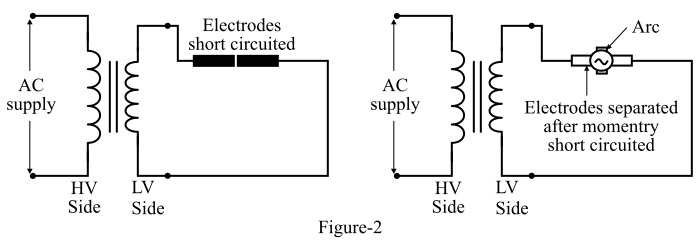
 Data Structure
Data Structure Networking
Networking RDBMS
RDBMS Operating System
Operating System Java
Java MS Excel
MS Excel iOS
iOS HTML
HTML CSS
CSS Android
Android Python
Python C Programming
C Programming C++
C++ C#
C# MongoDB
MongoDB MySQL
MySQL Javascript
Javascript PHP
PHP
- Selected Reading
- UPSC IAS Exams Notes
- Developer's Best Practices
- Questions and Answers
- Effective Resume Writing
- HR Interview Questions
- Computer Glossary
- Who is Who
Electric Arc Furnace: Working Principle & Types
Electric Arc Furnace
An electric furnace is the furnace that heats materials by means of an electric arc is called an electric arc furnace (EAF). Electric arc furnaces are mainly used for melting or extracting of ferrous or non-ferrous metals which need a high temperature operation. The electric arc furnace produces an electric arc which gives an arc temperature between 3000 °C and 3500 °C on L.T. (Low Tension) operation.
Basically, the electric arc is nothing but the flow electric current through an air gap between two conducting electrodes.
Working of Electric Arc Furnace
From the working of an electric arc furnace simply means how to create the electric arc and hence the heat produced in the furnace. The electric arc between two electrodes can be created by any of the following two methods −
H. T. (High Tension) method of striking an electric arc
L. T. (Low Tension) method of striking an electric arc
H. T. Strike Method
In the H. T. method of striking an electric arc, a constant air gap is maintained across a pair of conducting electrodes. The electrodes are connected to the high voltage secondary winding of a step-up transformer and the primary winding of the transformer is fed with a variable AC supply as shown in Figure-1.

Now, to strike an electric arc, the primary side voltage is gradually increased, which increases the voltage across the high tension secondary winding and hence across the electrodes. At a certain voltage, a stage comes when the medium between the two electrodes is ionized and becomes conducting. It is the stage when an electric arc is created between the two electrodes.
After striking the electric arc, the voltage across the electrodes has to be reduced from H. T. value to L. T. value, it is because the conducting gap between the electrodes has now negligibly low resistance as compared to the air gap resistance before striking of the arc. The H. T. voltage required depends upon the size and nature of the air gap between the two electrodes.
L. T. Striking Method
The circuit diagram of the L. T. method of striking the electric arc is shown in Figure-2. In this method, a low voltage of the order of supply voltage is enough to create an electric arc between the electrodes. In this method, the two conducting electrodes are connected to the low voltage secondary winding of a step-down transformer. These electrodes are momentarily short-circuited and are immediately separated resulting in the production of an arc.

Types of Electric Arc Furnaces
Electric arc furnaces can be classified into two types viz −
Direct Arc Furnace
Indirect Arc Furnace
Direct Arc Furnace
A direct electric arc furnace is the one in which the electric arc is struck between the electrode and the charge, to be heated, so that the arc current flows through the charge and there is a direct contact between the arc and the charge.
In case of direct electric arc furnace, the heating process is faster and the heating efficiency is also high. In addition to the arc heating, some additional heat is produced by the passes of the electric current through the charge.
Indirect Arc Furnace
An electric arc furnace in which the heat is produced by striking the arc between two electrodes and then transferred to the charge to be heated is called the indirect electric arc furnace.
In case of indirect electric arc furnace, the electric arc does not come in contact with the charge but heat is transferred through radiation from the electric arc to the top surface of the charge and through conduction from the top surface to the bottom layer in the charge.

